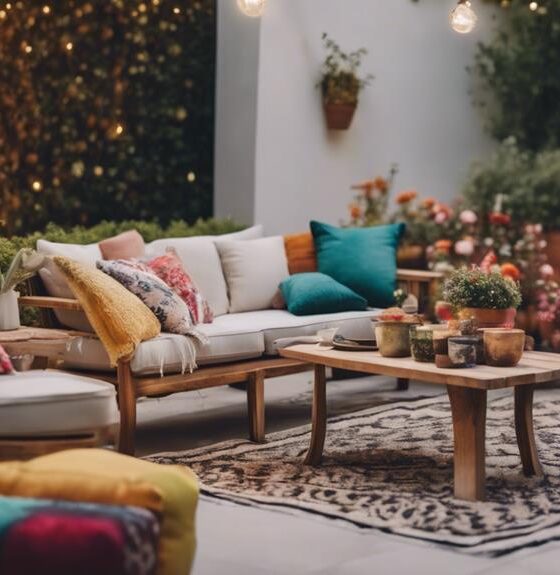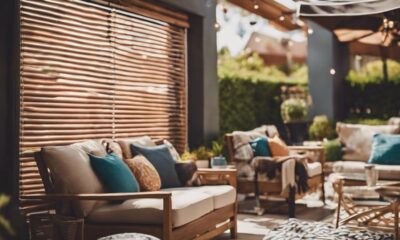Decor
Top Interior Design Schools for Aspiring Designers
Embark on a journey through the top interior design schools, where creativity flourishes and dreams take shape in the world of design…
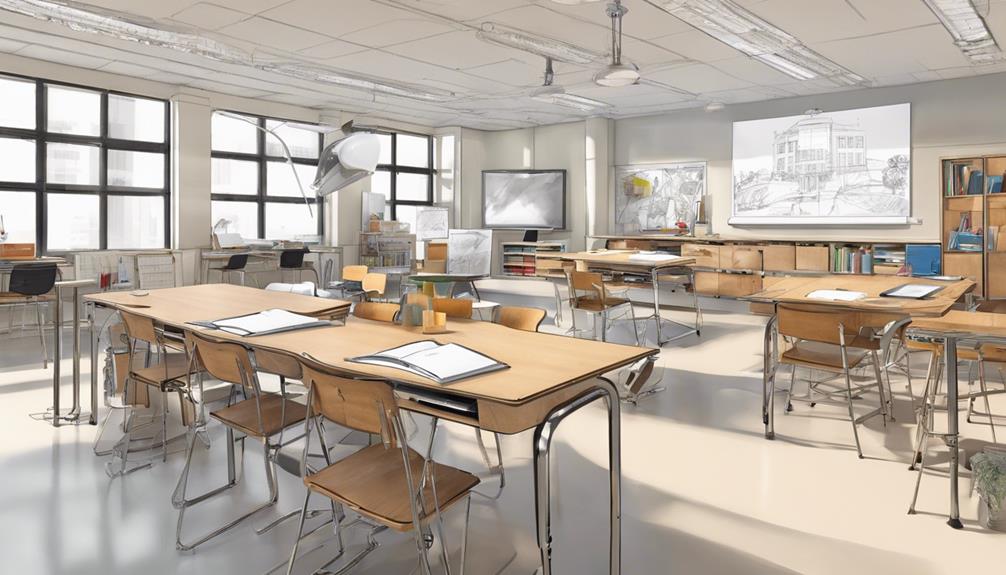
When it comes to navigating the landscape of top interior design schools, it's like stepping into a vibrant tapestry of possibilities. The intricate threads of education, creativity, and professional growth are interwoven in institutions that shape the future of design.
As we explore the avenues offered by these esteemed schools, we uncover a world where imagination meets practicality, and innovation is nurtured. Join us on this journey as we unravel the secrets behind the doors of prestigious design programs and unravel the keys to unlocking your potential in the world of interior design.
Key Takeaways
- Schools like Savannah College of Art and Design and Parsons offer high job placement rates.
- Universities such as Cornell and Rhode Island School of Design focus on innovation and practical experience.
- Specialized institutes like New York School of Interior Design provide industry connections and tailored programs.
- Factors to consider include accreditation, program offerings, internships, faculty expertise, and areas of focus.
Top Interior Design Schools Overview
As seasoned experts in the field, we fervently present a comprehensive overview of the top interior design schools. When considering a career in interior design, aspiring designers must choose the right educational path to hone their skills.
In New York, the Savannah College of Art and Design stands out with its high job placement rates, equipping students with the knowledge and expertise needed to excel in the industry. Parsons, The New School, holds a prestigious position as the pioneer of interior design curriculum in the US, emphasizing sustainability and innovation to prepare students for a dynamic field. Cornell University offers STEM-certified programs that delve into design innovation, sustainability, and health, providing a well-rounded education for future designers.
Furthermore, the Rhode Island School of Design focuses on practical studio work and hands-on experience, boasting notable alumni like Nicole Miller and James Mont. For those seeking specialized education, the New York School of Interior Design offers exclusive programs dedicated solely to interior design, along with strong industry connections in the heart of NYC.
These schools are at the forefront of shaping the next generation of talented designers, ensuring that students receive the best education to thrive in the competitive world of interior design.
Prestigious Universities Offering Interior Design Programs

Prestigious universities renowned for their exceptional interior design programs include Parsons School of Design in New York, NY. Parsons stands out for its pioneering interior design curriculum that offers a diverse range of degree programs to cater to different interests and career goals. Rhode Island School of Design (RISD) in Providence, RI is another top choice, placing a strong emphasis on studio work, hands-on experience, and a culture of experimentation, fostering creativity and innovation among students.
Savannah College of Art and Design (SCAD) in Savannah, GA has earned recognition from CIDA and boasts a high job placement rate, providing students with excellent prospects upon graduation. Pratt Institute in Brooklyn, NY is known for its focus on sustainability, social responsibility, and interdisciplinary collaboration in design education, preparing students to address real-world challenges in the field.
Additionally, the University of California, Los Angeles (UCLA) Extension in Los Angeles, CA offers a comprehensive interior design curriculum that emphasizes practical skills and real-world application, ensuring graduates are well-equipped for the industry's demands. These universities provide students with a solid foundation, hands-on experience, and opportunities for interdisciplinary collaboration, setting them on a path towards successful careers in interior design.
Specialized Design Institutes for Aspiring Designers
With a focus on specialized education in interior design, New York School of Interior Design (NYSID) stands out as a premier institution for aspiring designers. NYSID specializes solely in interior design education, offering BFA, MFA, and MPS programs. The school places a strong emphasis on practical skills and industry connections, giving students a competitive edge in the field.
Situated in NYC, NYSID provides networking opportunities with industry professionals, access to design showrooms, and participation in events. The faculty at NYSID consists of practicing professionals who bring real-world experience and insights into the classroom. Additionally, NYSID offers diverse program options like BFA, AAS, and Certificate programs, preparing students for various career paths in interior design.
- NYSID offers BFA, MFA, and MPS programs solely focused on interior design.
- Emphasis on practical skills and industry connections for a competitive edge.
- Networking opportunities with industry professionals in NYC.
- Faculty composed of practicing professionals with real-world experience.
- Diverse program options like BFA, AAS, and Certificate programs for various career paths.
Notable Interior Design Schools in the US
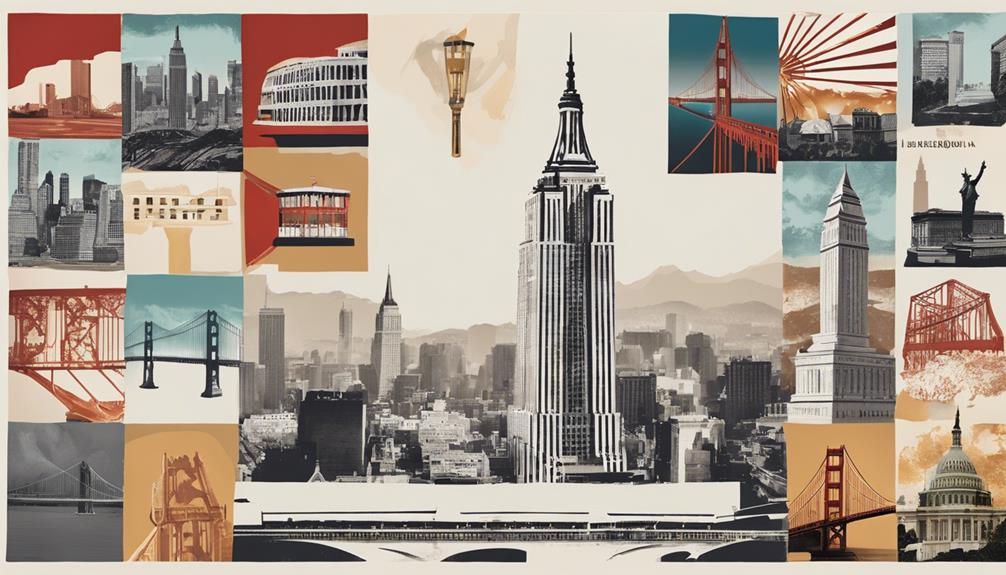
In the realm of interior design education in the United States, several institutions have garnered acclaim for their innovative programs and contributions to the field.
The New York School of Interior Design in New York, NY, stands out for its exclusive focus on interior design education, offering BFA, MFA, and MPS programs tailored to nurture budding designers.
Parsons School of Design in New York, NY, holds a significant spot in history as the pioneer of the first interior design curriculum in the US, paving the way for many aspiring designers.
Savannah College of Art and Design in Savannah, GA, shines with its CIDA accreditation and diverse program offerings including BFA, MA, and MFA degrees.
Pratt Institute in New York, NY, distinguishes itself by emphasizing sustainability and social responsibility in interior design education.
Additionally, the Rhode Island School of Design in Providence, RI, is known for its hands-on approach, studio work emphasis, and a culture of experimentation that enriches the interior design educational experience.
Factors to Consider When Choosing a Design School
Exploring the essential factors to consider when selecting a design school can significantly impact your interior design education and future career prospects. When choosing a design school, several key elements should guide your decision-making process:
- Accreditation Status: Ensure the school meets industry standards to guarantee a quality education.
- Program Offerings, Tuition Costs, and Course Curriculum: Align these factors with your career goals to make the most of your educational investment.
- Internship Opportunities: Look for schools that provide practical experiences to enhance your skills and build a professional network.
- Faculty Expertise: Investigate the experience and qualifications of the faculty members to ensure top-notch education and mentorship.
- Areas of Focus: Select a school whose specialization in interior design matches your personal interests and career aspirations.
Considering these factors will help you choose a design school that not only nurtures your creativity but also propels you towards a successful career in the dynamic field of interior design.
Frequently Asked Questions
What College Has the Best Interior Design Program?
We believe the best interior design program integrates creativity, sustainability, and industry connections. Our top picks are Savannah College of Art and Design for job placements, Parsons for innovation, Cornell for STEM focus, RISD for hands-on experience, and NYSID for practical skills.
Which Course Is Best for Becoming Interior Designer?
When becoming an interior designer, the best course is the Certified Residential Interior Designer program. It provides foundational principles and a credential endorsed by DSA. Instructor Natasha Lima-Younts' expertise ensures a successful design business start.
Which Is the Best Program for Interior Design?
When it comes to the best program for interior design, we prioritize a blend of accreditation, specialized curriculum, expert faculty, and real-world internships. Researching NCIDQ standards and aligning with career goals are key factors in selecting the perfect fit.
Which College Gives Best Placement for Interior Design?
We believe Cornell University offers the best placement for interior design. Their program excels in design innovation and sustainability, equipping students for successful careers. The specialized training and strong industry connections provide opportunities for graduates in the field.
Conclusion
As we journey through the world of interior design education, we're like artists seeking inspiration in a vast canvas of possibilities. By attending top interior design schools, we not only sharpen our skills but also paint our dreams with passion and purpose.
Each brushstroke of knowledge and experience adds depth and beauty to our artistic vision. Let's embrace the creative journey ahead, knowing that the best designs are yet to come.
- About the Author
- Latest Posts
Introducing Ron, the home decor aficionado at ByRetreat, whose passion for creating beautiful and inviting spaces is at the heart of his work. With his deep knowledge of home decor and his innate sense of style, Ron brings a wealth of expertise and a keen eye for detail to the ByRetreat team.
Ron’s love for home decor goes beyond aesthetics; he understands that our surroundings play a significant role in our overall well-being and productivity. With this in mind, Ron is dedicated to transforming remote workspaces into havens of comfort, functionality, and beauty.
Alfresco
What Is Alfresco Roof? Functional and Stylish Designs!
Discover how alfresco roofs combine functionality and style to transform outdoor spaces, offering protection and customization options that elevate outdoor living.
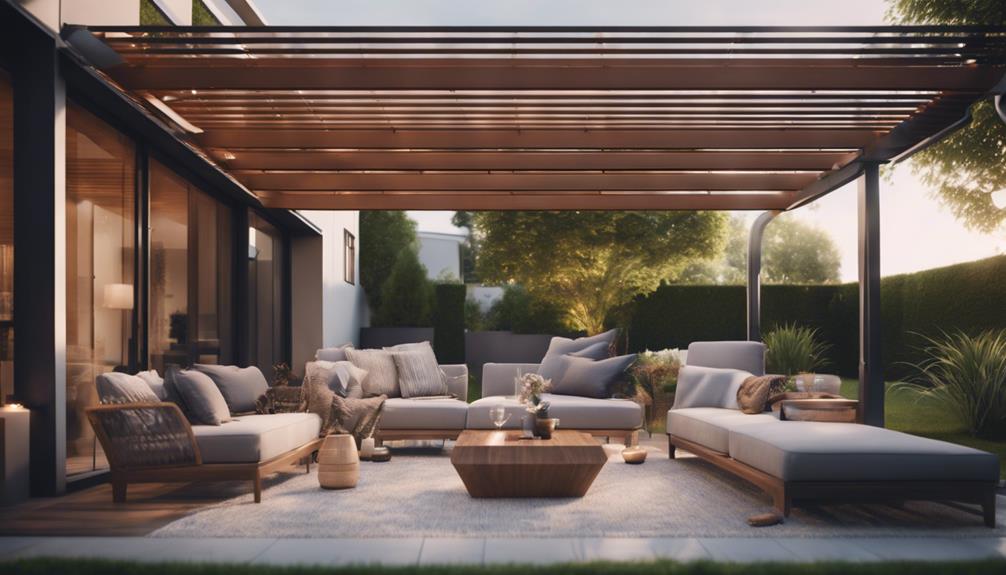
Alfresco roofs, also called outdoor living covers, offer functional and stylish designs that enhance outdoor spaces year-round. They provide protection from elements like sun, rain, and wind while integrating lighting options and customizable features such as retractable awnings. These roofs also add value to the property. Different materials like polycarbonate, Colorbond steel, and glass offer various benefits. Incorporating strategic lighting and proper maintenance can elevate the alfresco roof's appeal and longevity. Cost considerations depend on size, materials, and design complexity. Alfresco roofs bridge indoor and outdoor living, enhancing outdoor usability with their practical and aesthetic features.
Key Takeaways
- Alfresco roofs provide year-round outdoor usability.
- They offer protection from sun, rain, and wind.
- Integrated lighting options enhance ambiance.
- Customization features like retractable awnings are available.
- Adds property value with stylish and functional design.
Benefits of Alfresco Roofs
Alfresco roofs offer a myriad of benefits for homeowners seeking to maximize their outdoor living spaces. These structures provide protection from the elements, allowing for year-round use of outdoor areas. By shielding against sun, rain, and wind, alfresco roofs create a comfortable and functional outdoor environment perfect for dining and relaxation. Integrated lighting options further enhance the usability of outdoor spaces, extending their functionality well into the evening hours. Additionally, customization features like retractable awnings and louvre systems offer versatility and style, catering to individual preferences and needs.
Investing in an alfresco roof not only enhances your outdoor living experience but also adds value to your property. By seamlessly extending your living space into the outdoors, alfresco roofs elevate the overall appeal and utility of your home. Whether enjoying a meal al fresco or simply relaxing in the fresh air, the benefits of alfresco roofs make them a valuable addition for any homeowner looking to make the most of their outdoor space.
Types of Alfresco Roofing Materials

When considering options for roofing materials, homeowners can choose from a variety of materials to suit their alfresco design needs. Here are some common types of alfresco roofing materials:
- Polycarbonate: This material is lightweight, durable, and provides UV protection for outdoor spaces, making it a popular choice for alfresco areas.
- Colorbond steel: Offering a sleek and modern look, Colorbond steel comes in a wide range of colors, allowing homeowners to match their alfresco design seamlessly with their outdoor space.
- Glass: Glass roofing allows natural light to filter through, creating a bright and open atmosphere in alfresco areas, perfect for those who want to enjoy the outdoors while staying protected under a roof.
Each of these materials has its own unique advantages, catering to different preferences and needs when it comes to creating stylish and functional outdoor living spaces.
Design Ideas for Stylish Alfresco Roofs
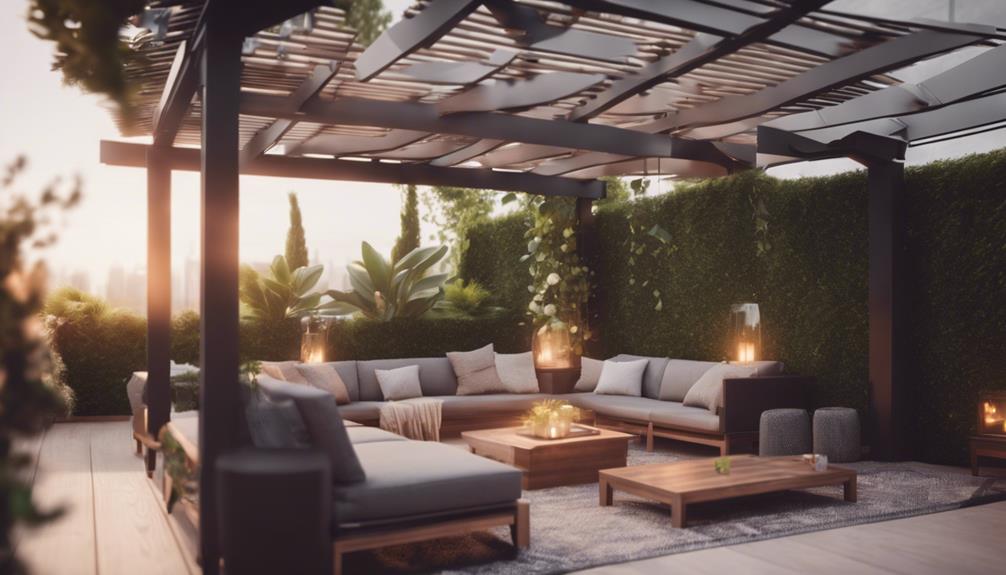
When contemplating design ideas for stylish alfresco roofs, it's crucial to explore roofing material options that suit both aesthetic and practical needs.
Incorporating strategic lighting and ambiance elements can create a welcoming outdoor space for various activities and gatherings.
Additionally, thoughtful outdoor furniture layout can enhance comfort and functionality, maximizing the alfresco area's usability and visual appeal.
Roofing Material Options
Among the various roofing material options for stylish alfresco roofs, timber stands out for its natural and rustic charm that seamlessly blends with outdoor surroundings. Timber roofing adds warmth and character to the outdoor patio or alfresco area, creating a cozy and inviting atmosphere for gatherings and relaxation.
- Polycarbonate: Durable, lightweight, and allows natural light to filter through, creating a bright and airy space.
- Colorbond Steel: Offers a modern and sleek look, available in a range of colors to complement different design schemes.
- Insulated Roofing Panels: Provide excellent thermal insulation, keeping the alfresco area comfortable in both hot and cold weather.
Each material option brings its unique benefits to the alfresco roof design. While timber exudes a natural feel, polycarbonate allows for ample natural light, Colorbond steel offers a contemporary aesthetic, and insulated roofing panels promote comfort year-round. Consider the desired ambiance and functionality when selecting the roofing material for your alfresco area.
Lighting and Ambiance
Integrated lighting plays a pivotal role in enhancing the ambiance of stylish alfresco roofs, especially for evening dining settings. By incorporating adjustable lighting features, different light levels can be achieved to create the perfect atmosphere for outdoor dining. Stylish designs seamlessly integrate lighting elements into the roof structure, adding both sophistication and functionality to the space. Strategic placement of lighting fixtures helps highlight key areas within the alfresco environment, enhancing its overall appeal.
When planning the lighting for an alfresco roof, it's crucial to take into account the desired ambiance and functionality. Soft, warm lighting can create a cozy and inviting atmosphere for intimate dinners, while brighter lights may be more suitable for lively gatherings. Well-thought-out lighting not only contributes to the aesthetics but also ensures practicality for nighttime use of the outdoor dining space.
Outdoor Furniture Layout
Strategically arranging outdoor furniture in stylish alfresco roofs is essential for optimizing space and enhancing the overall dining and lounging experience.
When designing the layout for your alfresco space, consider the following:
- Dining Sets: Utilize dining sets to create designated eating areas that are perfect for enjoying meals with family and friends.
- Benches: Incorporate benches for flexible seating options that can accommodate more guests or provide a cozy spot for lounging.
- Loungers: Adding loungers can enhance relaxation and create a spa-like atmosphere for unwinding in your outdoor sanctuary.
Incorporating Lighting in Alfresco Roof Design
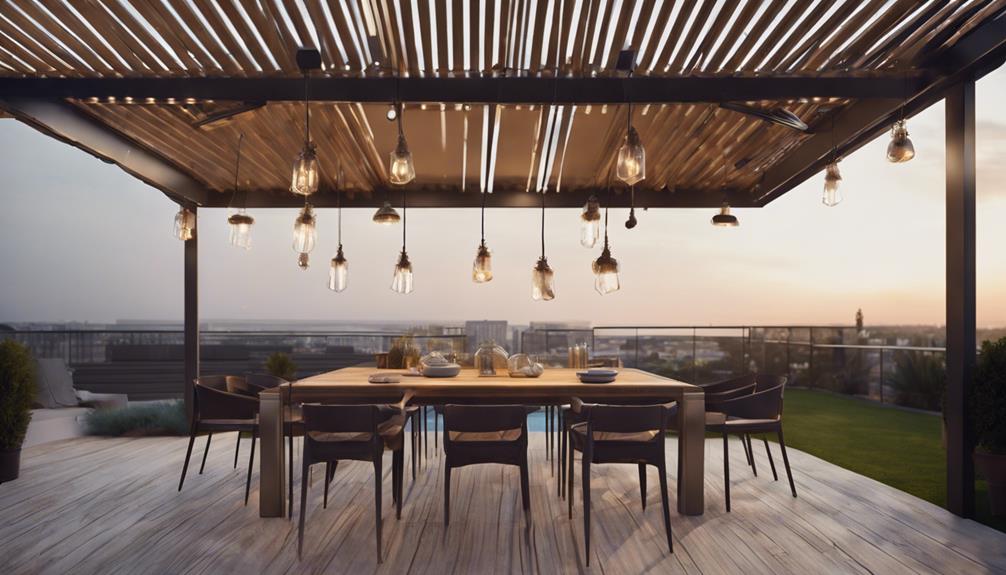
To enhance the ambiance and functionality of alfresco roof designs, incorporating lighting is essential. Lighting plays a crucial role in creating a welcoming atmosphere for both daytime and nighttime use. By strategically placing integrated lighting fixtures, different light levels can be achieved to cater to various activities in the alfresco living space, enhancing the overall dining experience. Popular choices for alfresco roof lighting include downlights, strip lights, and pendant lights, each offering a unique ambiance to the area. The right lighting design can transform the outdoor space into a cozy retreat, perfect for evening gatherings and dining experiences. Additionally, a well-thought-out lighting plan can extend the usability of the alfresco roof into the night, allowing for continued enjoyment of the outdoor living space after the sun sets.
| Lighting Type | Description | Best Use Cases |
|---|---|---|
| Downlights | Recessed lights in ceiling | General illumination |
| Strip Lights | Linear lights along edges | Accentuating architectural features |
| Pendant Lights | Hanging lights fixtures | Over dining or seating areas |
Alfresco Roof Maintenance Tips
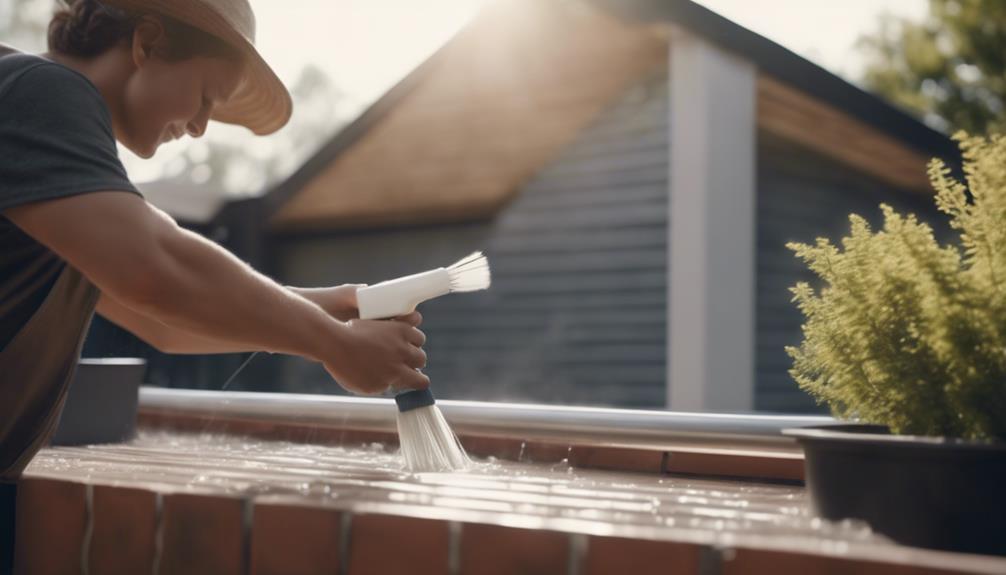
We must prioritize regular cleaning of the alfresco roof to prevent water pooling and debris accumulation.
It's essential to inspect for any signs of damage like cracks or leaks and address them promptly to maintain the roof's integrity.
Trimming nearby trees can also help prevent roof damage caused by branches and blockages.
Cleaning Alfresco Roof
Let's keep our alfresco roof in top condition by regularly cleaning it with a soft brush or cloth using mild soap and water to prevent dirt and debris buildup.
This simple maintenance routine can help preserve the roof's appearance and functionality for years to come. Remember to avoid harsh chemicals or abrasive materials that could potentially damage the surface of the roof.
- Use a soft brush or cloth with mild soap and water for gentle cleaning.
- Avoid harsh chemicals that may harm the roof material.
- Regularly inspect for damages and leaks to preserve the roof's integrity.
Maintaining a clean alfresco roof not only enhances the aesthetics of your outdoor kitchen but also creates a comfortable setting for gatherings and relaxation. By following these cleaning tips, you can guarantee that your alfresco roof remains in excellent condition, providing a pleasant outdoor experience for you and your guests.
Preventing Roof Leaks
Regularly inspecting seals, flashing, and joints is key to preventing water infiltration and leaks in alfresco roofs. Ensuring these components are intact and well-maintained is essential for safeguarding your outdoor living space from potential water damage. Additionally, it's important to clear debris and maintain proper drainage to prevent water pooling, which can lead to leaks in alfresco roofing.
Using high-quality materials and opting for professional installation can greatly reduce the risk of leaks in your alfresco roof. By investing in these aspects, you can enhance the longevity and durability of your outdoor living area.
Addressing any signs of damage or wear promptly is crucial in preventing leaks and preserving the structural integrity of your alfresco roof. Timely repairs and maintenance can help mitigate potential issues before they escalate into more significant problems.
Proper ventilation in the roof space is another crucial aspect to consider. Adequate ventilation helps reduce moisture buildup, which in turn can help prevent leaks in alfresco structures.
Cost Considerations for Alfresco Roofs

Considering the cost of alfresco roofs involves factoring in elements such as size, materials used, and design intricacy. When budgeting for an alfresco roof, keep in mind the following:
- Size: The larger the roof area, the more materials will be required, impacting the overall cost.
- Materials: Standard options like Colorbond steel typically range from $50 to $80 per square meter, while insulated roofing can cost between $80 to $120 per square meter.
- Design Complexity: Intricate designs or custom features such as lighting and fans can add to the total expenses.
Investing in an alfresco roof isn't just about cost; it's about creating the perfect focal point for your outdoor space. Quality materials and professional installation can enhance both the usability and value of your alfresco area.
Alfresco Roof Vs. Traditional Roofing

When comparing alfresco roofs to traditional roofing, one key distinction lies in their design and intended use. Alfresco roofs are specifically crafted to cover outdoor living spaces, offering protection from the elements like sun, rain, and wind.
In contrast, traditional roofing is primarily used for indoor spaces, focusing on sheltering the interior of a building. Alfresco roofs allow you to create a unique blend of indoor and outdoor living, unlike traditional roofs that are designed solely for indoor comfort.
The beauty of alfresco roofs lies in how they enhance the usability of outdoor areas, providing functional and stylish spaces for dining, entertaining, and relaxation. Traditional roofing, on the other hand, serves a more conventional purpose of protecting the interior of a building.
Alfresco roofs offer a modern twist to outdoor living, while traditional roofing maintains a classic approach to sheltering indoor spaces.
Frequently Asked Questions
What Is an Alfresco Roof?
An alfresco roof is a covering structure over an outdoor living area, providing protection from elements like sun, rain, and wind. It enhances usability, creating smooth indoor-outdoor connections, and adding value to the property.
What Is the Difference Between Patio and Alfresco?
When comparing patios and alfresco areas, patios are more basic ground-level outdoor spaces, while alfresco areas are designed to be stylish extensions of indoor living, offering integrated features like kitchens and seating for a complete outdoor experience.
What Is an Alfresco in a Home?
We love alfresco areas! They're outdoor living spaces in homes designed for dining, lounging, and entertaining. Covered to enjoy the outdoors while sheltered. Customizable with seating, dining, cooking setups, and decorative elements for comfort and style.
What Is Alfresco Terrace?
An alfresco terrace is an outdoor extension of a building, ideal for dining and entertainment. It seamlessly combines indoor and outdoor living, often featuring seating, dining areas, plants, and lighting. A well-designed terrace adds value and creates a stylish outdoor space.
Conclusion
To sum up, alfresco roofs offer both functionality and style, providing a practical solution for outdoor living spaces.
With a variety of materials and design options available, homeowners can create a stylish and comfortable outdoor area to enjoy year-round.
By incorporating lighting and following maintenance tips, alfresco roofs can enhance the overall appeal of a property.
Consider the cost and benefits of alfresco roofs compared to traditional roofing to make the best choice for your outdoor space.
- About the Author
- Latest Posts
Introducing Ron, the home decor aficionado at ByRetreat, whose passion for creating beautiful and inviting spaces is at the heart of his work. With his deep knowledge of home decor and his innate sense of style, Ron brings a wealth of expertise and a keen eye for detail to the ByRetreat team.
Ron’s love for home decor goes beyond aesthetics; he understands that our surroundings play a significant role in our overall well-being and productivity. With this in mind, Ron is dedicated to transforming remote workspaces into havens of comfort, functionality, and beauty.
Alfresco
What Is Alfresco Painting? Artistic Techniques Explained!
Take a journey through time with alfresco painting, exploring ancient techniques and vibrant colors in the great outdoors.

Alfresco painting, linked to 'in the fresh air', showcases artistic techniques outdoors with roots dating to the Minoans and Romans, thriving during the Italian Renaissance. Tools like portable easels and water-based pigments, along with techniques such as intonaco and fresco secco, are essential. Plaster prep guarantees vibrant artwork and detailed pieces rely on proper pressure and specialized brushes. Sinopia aids in large-scale murals, using red earth pigment for preliminary sketches. Immerse yourself in this rich art form to discover a world of creativity and history.
Key Takeaways
- Originating from Italian Renaissance, alfresco painting is done outdoors.
- Tools include portable easels, water-based pigments, and lightweight materials.
- Techniques like intonaco and fresco secco for plaster preparation and painting.
- Applying even pressure with specialized brushes crucial for detailed artwork.
- Sinopia, a red earth pigment, aids in preliminary sketches for large-scale murals.
Origins of Alfresco Painting
The origins of alfresco painting can be traced back to ancient civilizations such as the Minoans and Romans. The term 'alfresco' originates from the Italian word for 'in the fresh air,' reflecting the practice of painting outdoors on fresh plaster. During the Italian Renaissance, alfresco painting rose in popularity as a technique for creating enduring and monumental works of art. Artists like Giotto, Masaccio, and Michelangelo are celebrated for their exceptional use of this method in producing iconic frescoes.
One of the key aspects of alfresco painting is the application of water-based pigments on wet plaster. This process allows the colors to fuse with the plaster as they dry and set, ensuring a lasting bond between the artwork and the wall.
The careful manipulation of wet plaster and pigments during the painting process is crucial in achieving vibrant and long-lasting frescoes that continue to captivate audiences centuries later.
Tools and Materials Used

For alfresco painting, artists typically utilize water-based pigments, brushes, and a suitable painting surface. When engaging in fresco painting, it is important to use materials that can withstand outdoor conditions and allow for the proper adherence of pigment particles to the surface. Here is a breakdown of the tools and materials commonly used for alfresco painting:
| Tools | Materials | Accessories |
|---|---|---|
| Portable easels | Canvas panels | Umbrellas |
| Paint palettes | Boards | Stools |
| Containers | Paper | Other comfort accessories |
These tools and materials play a significant role in the technique of alfresco painting, enabling artists to capture the essence of outdoor scenes while working with the unique challenges and opportunities presented by natural lighting and outdoor settings. By using the right tools and materials, artists can enhance their plein air painting experience and create stunning works of art that reflect the beauty of the surroundings.
Step-by-Step Process Overview

First, we gather our materials and tools, ensuring we have everything needed for the painting session.
Next, we set up outdoors in a suitable location that inspires creativity and offers a compelling subject to paint.
This process sets the foundation for our alfresco painting experience, allowing us to immerse ourselves in the natural surroundings and capture them on canvas.
Materials and Tools
Our alfresco painting sessions rely on lightweight, easily transportable materials and tools for an efficient outdoor creative experience. When practicing the fresco technique outdoors, artists typically opt for a portable easel, canvas, brushes, and paints.
This approach to painting has a rich history in art, dating back to the early 16th century. To guarantee convenience during plein air painting, artists often select compact paint kits and a limited color palette for on-the-go creativity.
Sturdy easels and collapsible chairs are essential for outdoor painting, along with weather-resistant supplies to withstand the elements. Additionally, crucial tools such as a palette knife, palette, water container, and a sun hat for comfort are commonly used during alfresco painting sessions.
Setting up Outdoors
Selecting a location with ample natural light and creating a comfortable working environment are essential steps in setting up outdoors for alfresco painting.
When preparing for an alfresco painting session, artists often opt for scenic landscapes or captivating urban scenes as their subjects. To facilitate their creative process, artists rely on tools like portable easels, a variety of brushes, a limited color palette, and a sturdy surface to work on.
Weather conditions play an important role in outdoor painting, prompting artists to be ready for changes such as wind, rain, or excessive sunlight. Plein air umbrellas, sunscreen, and portable seating can enhance comfort and productivity during alfresco painting.
Importance of Plaster Preparation
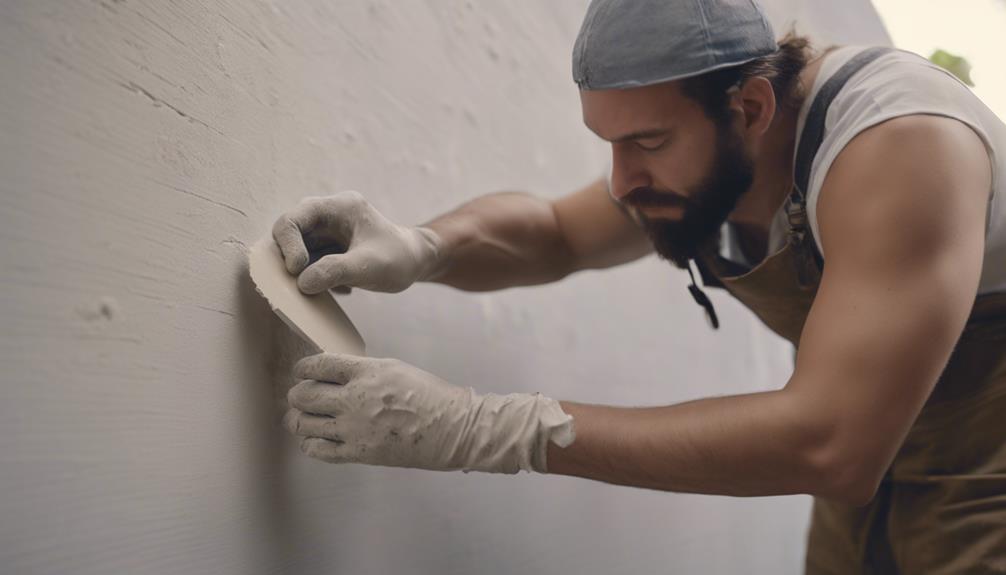
Why is proper plaster preparation essential for the success of alfresco painting?
Adequate plaster preparation is critical in alfresco painting as it sets the foundation for the artwork. The quality of the plaster directly impacts how well the pigments adhere to the surface and how long the painting will last.
By meticulously applying layers of specially formulated mixtures, artists create a durable canvas that supports their artistic vision. Techniques like intonaco and arriccio play an important role in achieving the desired texture and finish of the plaster, enhancing the final artwork.
Skilled plaster preparation not only ensures a smooth surface for painting but also allows artists to create vibrant and long-lasting alfresco paintings that can withstand the test of time. Essentially, the art of plaster preparation is a fundamental step in the alfresco painting process, contributing significantly to the overall quality and longevity of the finished piece.
Techniques for Detailed Artwork
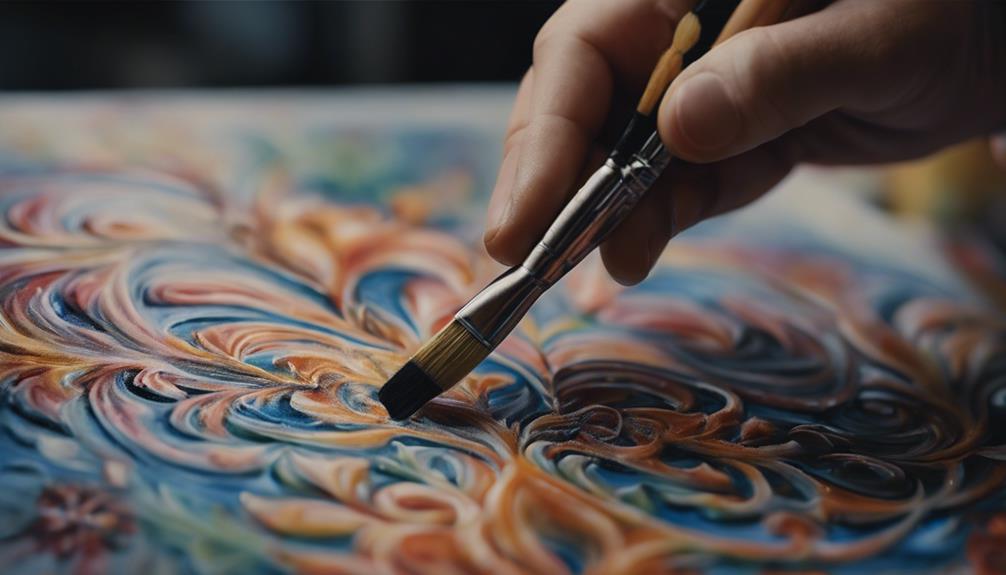
Proper plaster preparation sets the stage for detailed artwork in alfresco painting, allowing artists to employ techniques like the fresco secco method for intricate designs and refined results. When working with the fresco secco technique, artists can achieve intricate details by painting on dry plaster. This method offers more precision and control, making it ideal for adding fine lines, intricate patterns, and delicate shading to the artwork. Utilizing specialized brushes is crucial in alfresco painting to achieve these intricate designs. These brushes are designed to help artists create detailed textures and refine their work with precision.
| Techniques for Detailed Artwork | |
|---|---|
| Fresco Secco Technique | Working on dry plaster allows for intricate details. |
| Intricate Details | Achieved through precise painting methods. |
| Specialized Brushes | Essential for creating refined and detailed artwork. |
Tips for Successful Transfers

To achieve successful transfers in alfresco painting, we must prioritize proper surface preparation, the selection of the appropriate transfer medium, and the application of even pressure during the process.
By applying a layer of colla and cleaning the surface diligently, we set the stage for a smooth transfer without any interference.
Additionally, mixing Colla Freddo with water and carefully securing the fresco during transfer are key steps for ensuring the artwork remains intact and undamaged.
Proper Surface Preparation
Ensuring a clean and smooth wall surface is vital for successful fresco transfers. Before beginning the transfer process, it's important to remove any dust, dirt, or contaminants that could interfere with the adhesion of the artwork.
Priming the wall with a suitable plaster mix helps create a strong foundation for the fresco transfer to adhere to securely. The choice of tools, such as trowels and brushes, plays a significant role in achieving an even and well-prepared surface.
Attention to detail during surface preparation is key to maintaining the integrity and quality of the transferred fresco artwork. By meticulously cleaning the wall surface, priming it correctly, and using the appropriate tools, artists can ensure that their fresco transfers are successful and visually appealing.
Proper surface preparation sets the stage for a seamless transfer process and contributes to the longevity of the artwork once completed.
Choosing Transfer Medium
For successful fresco transfers, the selection of transfer medium is vital in achieving desired outcomes and ensuring a smooth application process. When choosing a transfer medium, consider factors like the surface texture and the final look you aim to achieve. Acrylic medium is often a popular choice for fresco transfers due to its ability to create smooth and consistent results. Transparency and drying time are essential characteristics to evaluate when selecting a transfer medium to guarantee successful transfers onto various surfaces.
To help you better understand the differences between transfer mediums, here is a table outlining some key features:
| Transfer Medium | Surface Compatibility | Transparency | Drying Time |
|---|---|---|---|
| Acrylic Medium | Smooth surfaces | Transparent | Quick drying |
| Gel Medium | Textured surfaces | Semi-transparent | Longer drying time |
| Transfer Paper | Versatile | Transparent | Varies based on type |
| Wax Medium | Matte surfaces | Opaque | Slow drying |
Experimenting with different transfer mediums can lead to unique effects, so feel free to explore various options to find what works best for your artistic vision.
Applying Even Pressure
Let's emphasize the importance of maintaining consistent and gentle pressure throughout the fresco transfer process to guarantee a flawless outcome. Applying even pressure is essential in ensuring a smooth and successful transfer of the artwork.
Any uneven pressure can potentially distort or damage the transferred image, impacting the final result greatly. To preserve the integrity of the fresco, it's essential to apply consistent pressure evenly across its entire surface. Proper distribution of pressure is crucial for maintaining the details and quality of the original artwork during the transfer process.
One effective way to achieve this is by utilizing soft tools or rollers, which can help in applying even pressure for a precise and accurate transfer. By employing these techniques, artists can ensure that the transferred fresco retains its original beauty and intricacies without any distortions or imperfections caused by uneven pressure.
Sinopia in Alfresco Painting

In alfresco painting, sinopia serves as an essential preliminary sketch on the plaster before the final paint layers are applied. This technique, dating back to ancient times, involves outlining the composition in red earth pigment to guide the placement of figures and elements in the fresco.
The use of sinopia aids artists in executing large-scale murals by ensuring accuracy and cohesion in the design. By drawing the sinopia on the plaster, artists can visualize the final artwork and plan out details before applying subsequent layers of paint.
The red earth pigment of sinopia allows for clear outlines that remain visible through the final paint layers, acting as a roadmap for the artist during the painting process.
Frequently Asked Questions
What Is the Fresco Painting Technique?
Fresco painting technique involves applying water-based pigments on freshly laid plaster. Buon Fresco requires multiple plaster coats and painting on the final smooth layer. Fresco Secco uses wetted dry walls for detailed work.
What Does Al Fresco Mean in Painting?
Al fresco in painting means creating art outdoors, directly inspired by nature's beauty. Artists use oil paints or watercolors, capturing fleeting moments in the open air. This technique, rooted in tradition, allows us to embrace spontaneity and nature's essence.
How Does an Artist Create a True Fresco Painting?
To create a true fresco painting, we apply water-based pigments onto freshly laid wet plaster. The colors are made by grinding dry-powder pigments in pure water. The artist transfers the design outlines before painting.
Why Is Fresco Painting Significant?
Fresco painting is significant for its enduring colors that meld with the plaster, creating lasting artworks. Originating in ancient civilizations, this technique reached its pinnacle during the Italian Renaissance, showcasing grandeur and beauty.
Conclusion
To sum up, alfresco painting is a timeless artistic technique that requires skill, patience, and attention to detail.
The process of creating artwork on plastered walls or ceilings dates back to ancient times, showcasing the enduring beauty and craftsmanship of this method.
While it may seem challenging at first, with the right tools and techniques, anyone can master the art of alfresco painting.
So, don't hesitate to explore your creativity and let your imagination run wild on the canvas of plastered surfaces!
- About the Author
- Latest Posts
Introducing Ron, the home decor aficionado at ByRetreat, whose passion for creating beautiful and inviting spaces is at the heart of his work. With his deep knowledge of home decor and his innate sense of style, Ron brings a wealth of expertise and a keen eye for detail to the ByRetreat team.
Ron’s love for home decor goes beyond aesthetics; he understands that our surroundings play a significant role in our overall well-being and productivity. With this in mind, Ron is dedicated to transforming remote workspaces into havens of comfort, functionality, and beauty.
Alfresco
What Is Alfresco Lounge? Creating Relaxing Outdoor Spaces!
Wondering how to turn your outdoor space into a stylish oasis? Alfresco lounge offers durable and sophisticated furniture for ultimate comfort and relaxation!
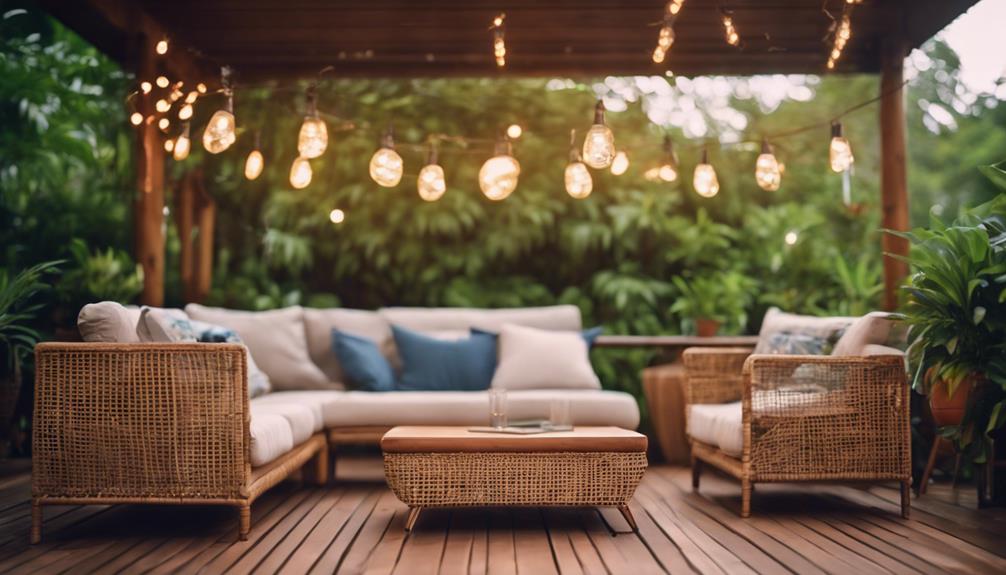
Alfresco lounge creates outdoor spaces for stylish comfort. It offers durable, weather-resistant furniture designed to withstand elements. The lounge furniture provides cozy seating that elevates outdoor areas with sophistication. This transformation turns outdoor spaces into relaxing retreats or entertaining zones, perfect for various weather conditions.
Key Takeaways
- Alfresco lounge furniture is durable and weather-resistant for outdoor use.
- Design alfresco spaces with comfortable seating and ambient lighting.
- Choose furniture like rattan or teak for weather resistance and style.
- Create a cozy outdoor retreat with seating, lighting, and accessories.
- Maintain alfresco furniture by cleaning, storing, and protecting from elements.
Benefits of Alfresco Lounge Furniture
When considering alfresco lounge furniture, we benefit from its durability and weather resistance for outdoor use. This type of furniture is specifically designed to withstand various weather conditions, guaranteeing it remains in good condition even when exposed to the elements.
Not only does alfresco lounge furniture provide a comfortable seating option for outdoor spaces, but it also adds a touch of style and sophistication. With a wide range of designs and materials available, individuals can choose furniture that suits their preferences and complements the overall design of their outdoor space.
Investing in quality alfresco lounge furniture can transform a regular backyard into a relaxing retreat or an entertainment area for gatherings with friends and family. The durability of this furniture ensures that it will last for a long time, making it a worthwhile investment for enhancing the overall look and feel of your outdoor space.
Design Tips for Alfresco Spaces

Let's explore effective design tips for creating inviting and relaxing alfresco spaces. When designing your outdoor living area, consider incorporating the following elements to enhance the comfort and style of your alfresco lounge:
- Comfortable Seating:
Choose outdoor furniture that's both comfortable and durable, such as plush sofas, lounge chairs, or hammocks, to create a cozy seating area for relaxation.
- Ambient Lighting:
Install outdoor lighting fixtures like string lights, lanterns, or solar-powered lights to create a warm and inviting atmosphere in the evenings for outdoor entertainment.
- Weather-Resistant Materials:
Opt for furniture made from weather-resistant materials like rattan, wicker, or teak to guarantee longevity and withstand outdoor elements.
- Stylish Outdoor Accessories:
Add finishing touches like outdoor rugs, cushions, and throw blankets to elevate the aesthetics of your alfresco space and make it a stylish relaxation area.
Choosing the Right Alfresco Furniture
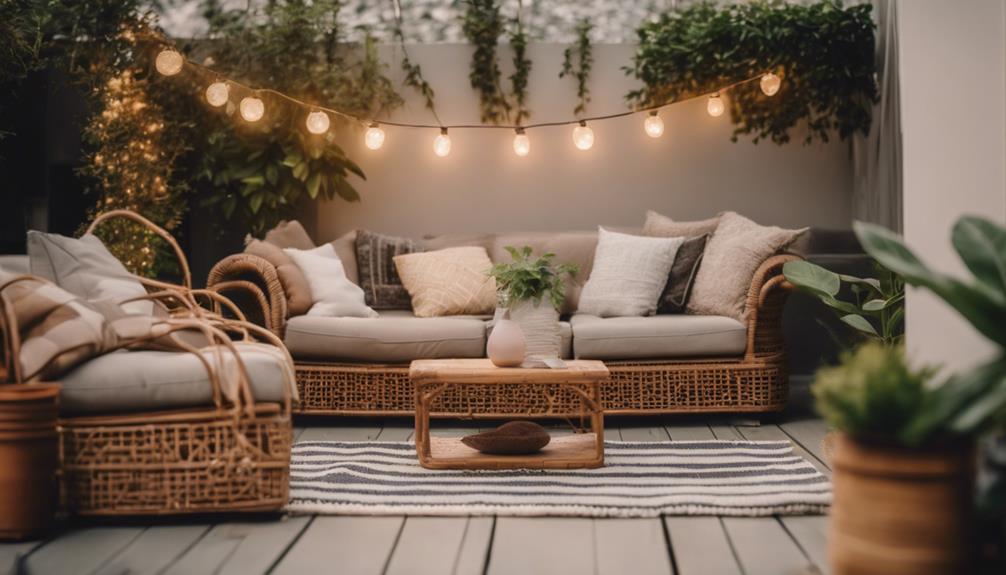
We can enhance our alfresco lounge by carefully selecting the right alfresco furniture that combines functionality and style to create an outdoor space ideal for relaxation and entertainment.
When choosing alfresco furniture for our outdoor living space, we should consider pieces like the Hamptons 3 seater sofa and armchair, offering both comfort and elegance for our guests. Rattan side tables and armchairs are durable options that can withstand various weather conditions, providing long-lasting functionality.
Creating a stunning outdoor entertainment area can be achieved by investing in lounge seating, coffee tables, and other furniture and decor that complement the overall design. With a wide range of alfresco furniture options available, we can personalize our outdoor space to suit our preferences and needs.
Practical choices like the Hampton Rattan Dining Chair can help set up cozy outdoor dining and relaxation areas, enhancing the comfort and enjoyment of our outdoor retreat.
Creating a Cozy Outdoor Retreat
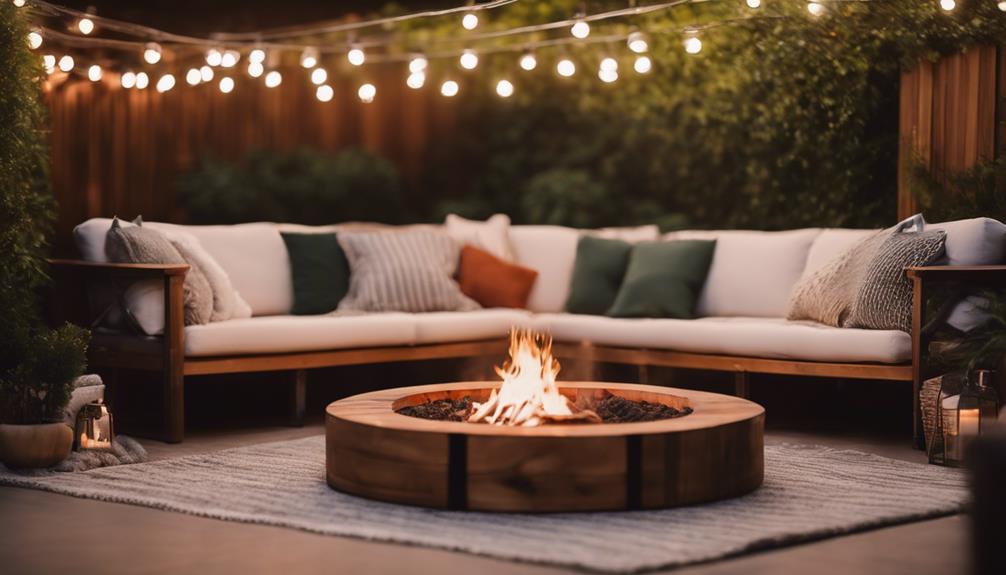
To create a cozy outdoor retreat, consider incorporating comfortable seating, ambient lighting, and greenery to enhance the relaxation and comfort of your alfresco lounge.
Here are some ideas to help you design a tranquil outdoor space:
- Comfortable Seating: Invest in outdoor loungers, hammocks, or day beds for ultimate relaxation.
- Ambient Lighting: Set the mood with soft lighting from lanterns, string lights, or candles.
- Outdoor Accessories: Add elements like outdoor cushions, rugs, and a fire pit for extra coziness.
- Greenery: Bring nature closer by incorporating plants, trees, and flowers to create a soothing environment.
Maintenance Tips for Alfresco Furniture
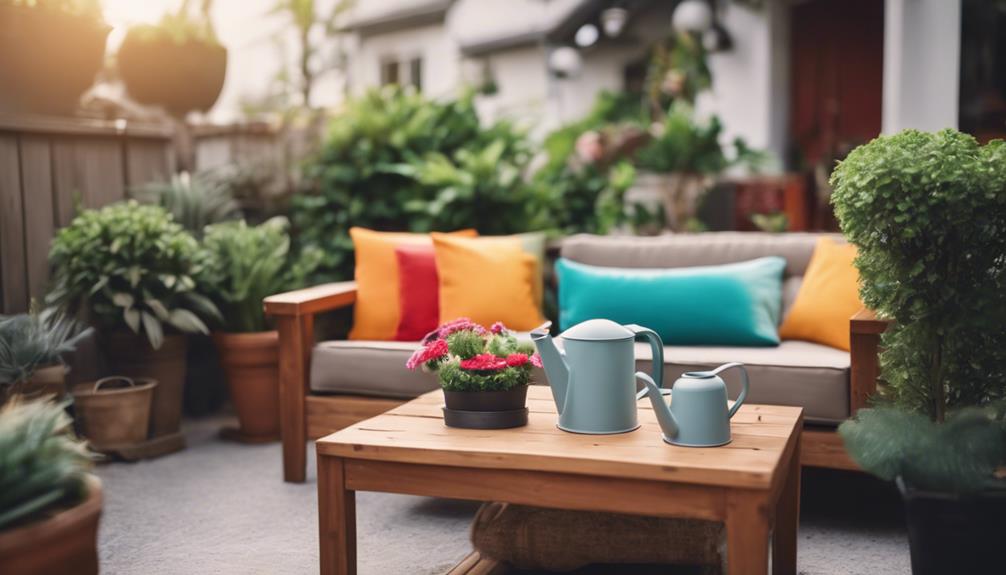
Regular maintenance of alfresco furniture is important to guarantee its durability and appearance remain intact over time. To clean and maintain outdoor furniture, use a mixture of mild soap and water for materials like rattan, wicker, or metal, avoiding harsh chemicals that may cause damage.
It's essential to protect furniture from the elements by storing cushions and pillows when not in use, preventing weather damage and extending their lifespan. For wooden furniture, apply a protective sealant or cover to shield it from the elements and maintain its appearance.
Regularly checking for wear and tear, such as loose joints or rust, is crucial to address any issues promptly and prevent further damage. By following these maintenance tips and taking preventive measures against weather damage, you can prolong the lifespan of your alfresco furniture and ensure it stays in top condition for years to come.
Frequently Asked Questions
What Is an Outdoor Alfresco Area?
An outdoor alfresco area is a designated space outside the main house for relaxation and entertainment. It typically includes furniture like sofas, chairs, tables, and accessories to create a cozy outdoor living space.
What Is an Alfresco Space?
An alfresco space is an outdoor area designed for relaxation, entertainment, and dining. It includes elements like outdoor furniture, lighting, shading, and greenery. Alfresco spaces vary in size and style, catering to different preferences.
What Is the Difference Between a Patio and an Alfresco?
A patio is a paved outdoor area, while an alfresco is a covered space for dining and entertaining. Alfresco areas offer more amenities like outdoor kitchens and seating. They provide sheltered outdoor living, blending indoor comfort with nature.
What Does an Alfresco Mean?
When we say "an alfresco," we're talking about enjoying the outdoors freely. It's about relishing the fresh air and creating cozy spaces outside. Alfresco signifies a blend of nature and comfort, perfect for relaxation.
Conclusion
To sum up, creating an alfresco lounge is a great way to enhance your outdoor living space. By carefully selecting the right furniture, designing a cozy retreat, and maintaining it properly, you can enjoy relaxing moments in the fresh air.
So, whether you're hosting gatherings or simply unwinding after a long day, an alfresco lounge provides the perfect setting for enjoying the outdoors in comfort and style.
- About the Author
- Latest Posts
Introducing Ron, the home decor aficionado at ByRetreat, whose passion for creating beautiful and inviting spaces is at the heart of his work. With his deep knowledge of home decor and his innate sense of style, Ron brings a wealth of expertise and a keen eye for detail to the ByRetreat team.
Ron’s love for home decor goes beyond aesthetics; he understands that our surroundings play a significant role in our overall well-being and productivity. With this in mind, Ron is dedicated to transforming remote workspaces into havens of comfort, functionality, and beauty.
-

 Vetted2 weeks ago
Vetted2 weeks ago15 Best Leather Restorer Products to Revive Your Furniture and Accessories
-

 Vetted2 weeks ago
Vetted2 weeks ago15 Best Contact Paper for Kitchen Cabinets to Elevate Your Home Decor
-

 Vetted3 weeks ago
Vetted3 weeks ago15 Best Leg Massagers to Relieve Tension and Improve Circulation – Ultimate Guide
-

 Vetted4 weeks ago
Vetted4 weeks ago14 Best Lawn Tractors of 2024 – Ultimate Guide for Your Yard Maintenance
-

 Vetted1 week ago
Vetted1 week ago15 Best Drain Snakes to Unclog Your Pipes Like a Pro
-

 Vetted4 weeks ago
Vetted4 weeks ago15 Best Commercial Backpack Vacuums for Efficient Cleaning Tasks
-
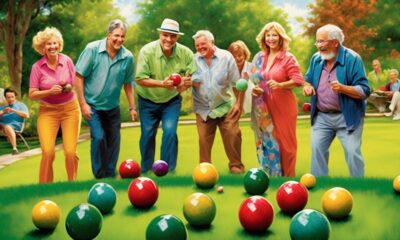
 Vetted3 weeks ago
Vetted3 weeks ago15 Best Lawn Games for Adults to Elevate Your Outdoor Gatherings
-

 Vetted4 weeks ago
Vetted4 weeks ago15 Best Group Games for Adults to Spice Up Your Next Gathering

















